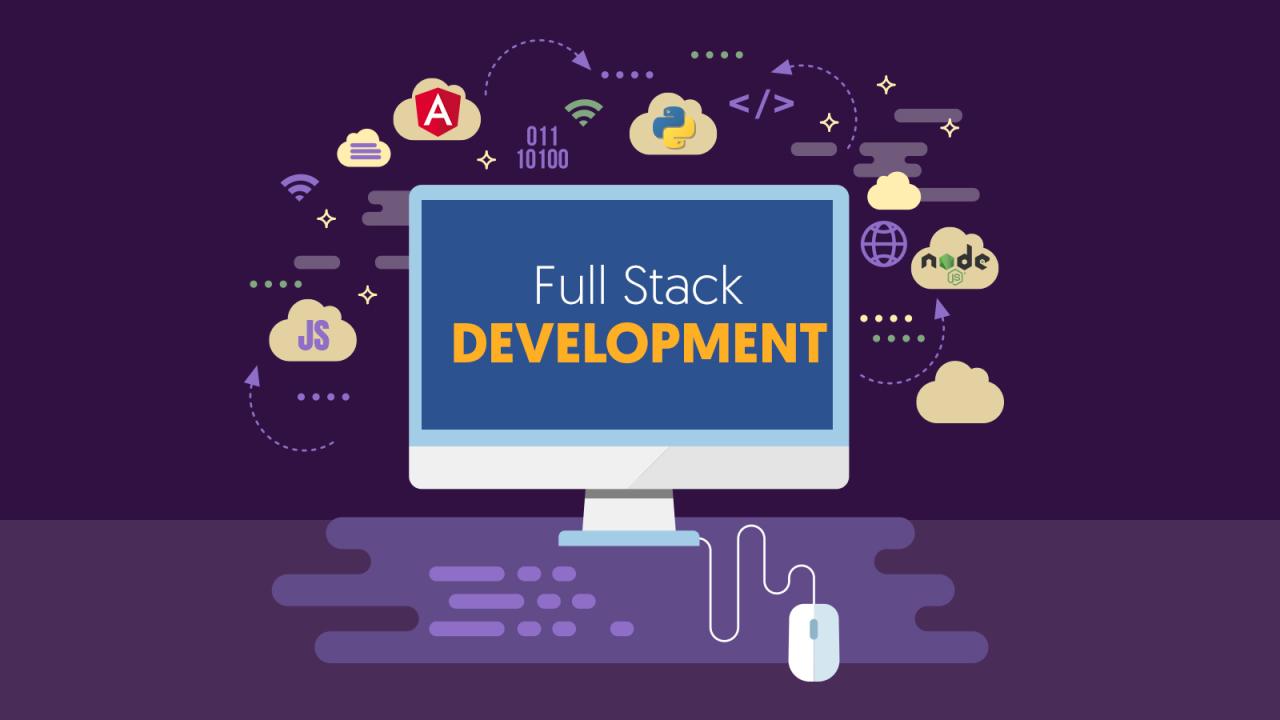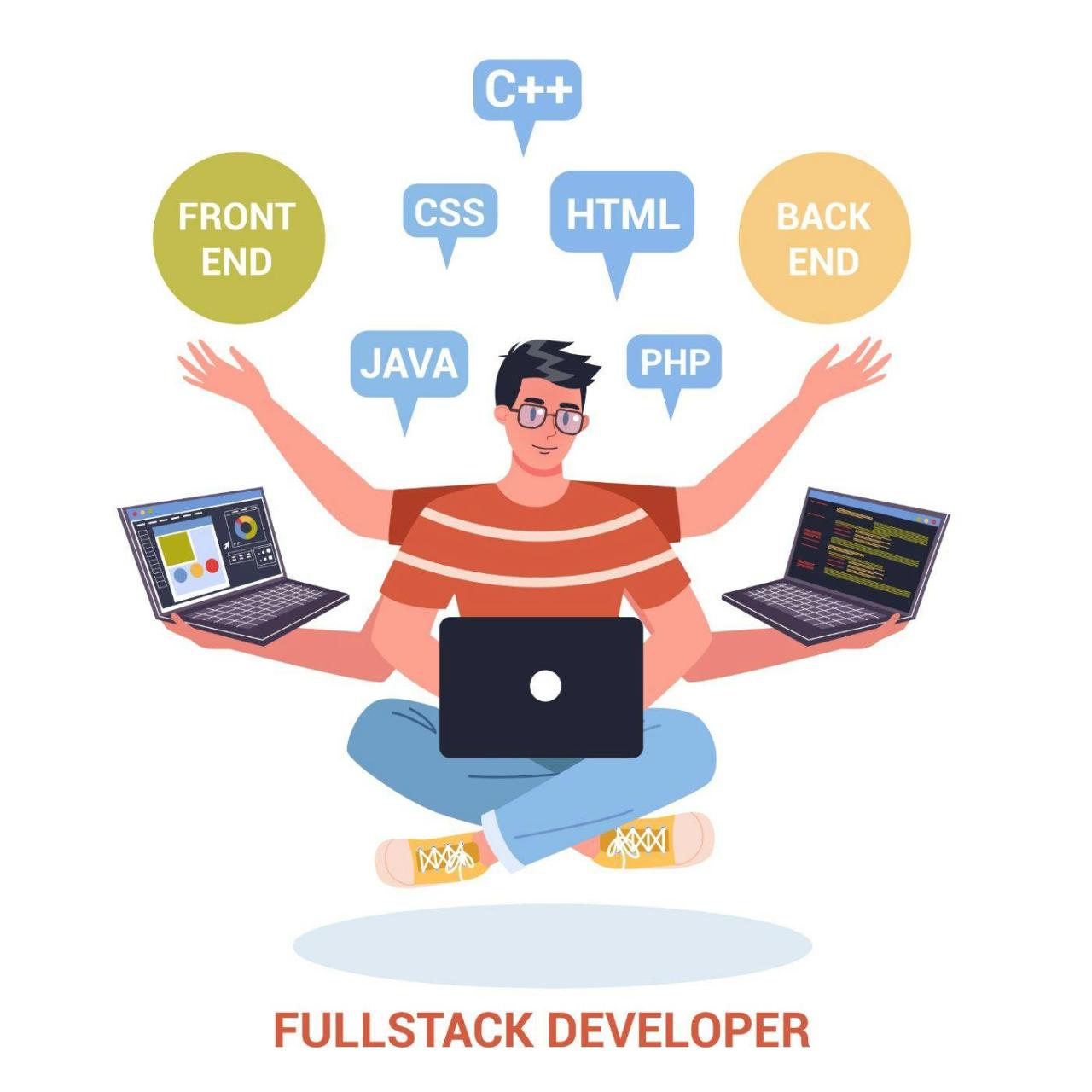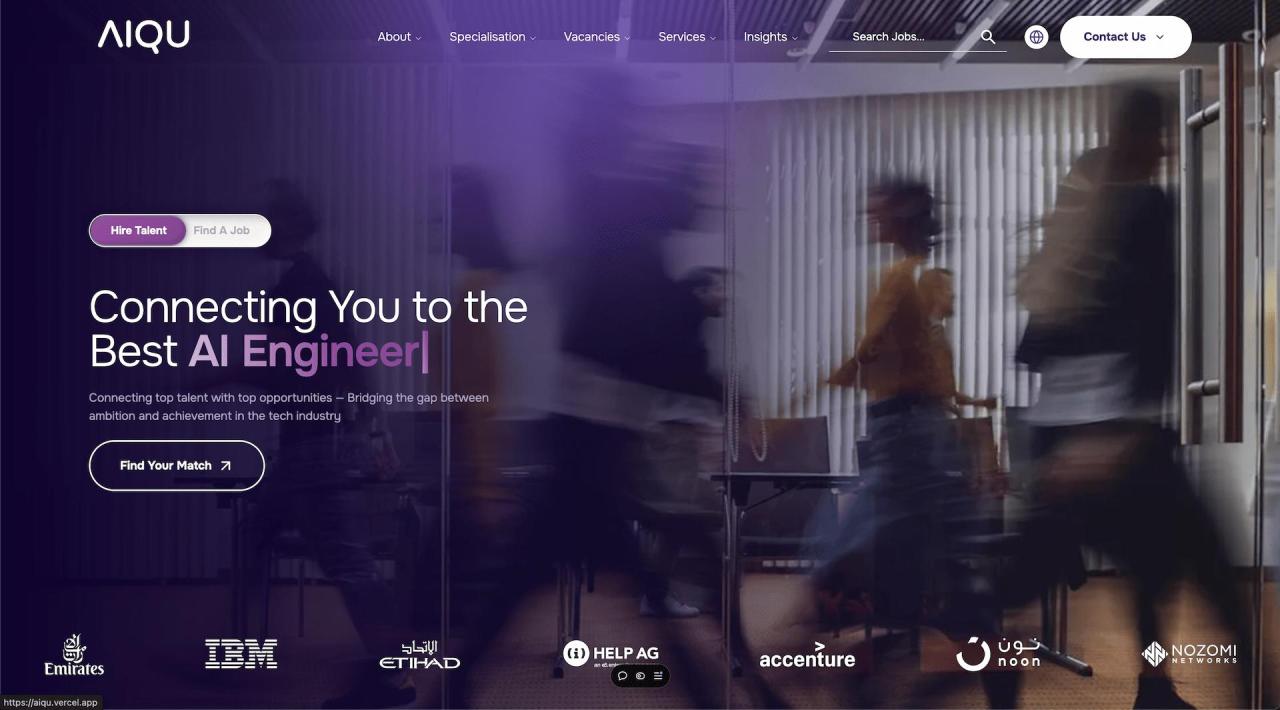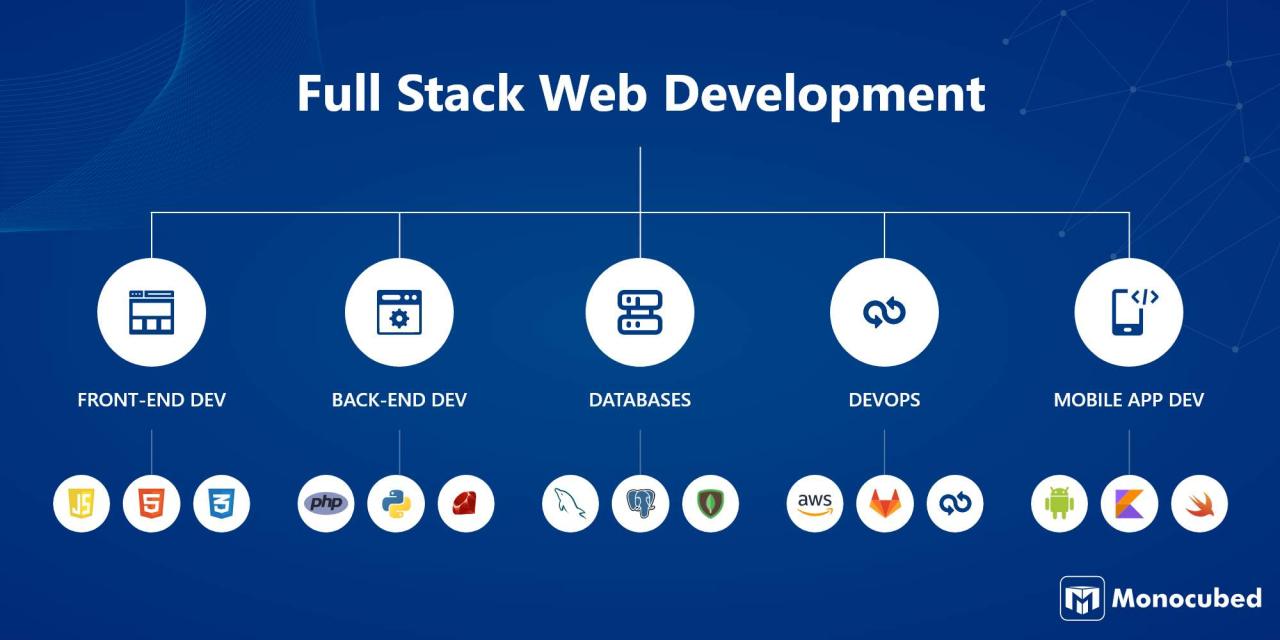Full stack developers are the superheroes of the web development world, wielding powers over both the front-end (what users see) and the back-end (the behind-the-scenes magic). They’re the masters of multiple programming languages, frameworks, and databases, capable of building entire applications from concept to deployment. This guide dives into the exciting world of full stack development, exploring its core competencies, essential skills, and the promising future it holds.
We’ll cover everything from choosing the right tech stack (like MERN, MEAN, or LAMP) to mastering crucial skills in databases and debugging. We’ll also look at real-world applications and explore the various career paths open to full-stack developers, including salary expectations and future trends. Get ready to become a full-stack expert!
Defining Full Stack Development
Full-stack development encompasses the entire process of building and deploying web applications, bridging the gap between front-end and back-end development. This means full-stack developers possess a broad skillset, enabling them to work on all aspects of a project, from user interface design to server-side logic and database management.
Core Competencies of a Full-Stack Developer

A full-stack developer’s core competencies include proficiency in front-end technologies (HTML, CSS, JavaScript, and related frameworks), back-end technologies (server-side languages, databases, and APIs), and a general understanding of DevOps principles. Strong problem-solving skills and the ability to work independently or collaboratively are also essential.
Full-Stack Development Specializations, Full stack developer
While full-stack developers possess broad skills, specializations exist. Popular stacks include MERN (MongoDB, Express.js, React, Node.js), MEAN (MongoDB, Express.js, Angular, Node.js), and LAMP (Linux, Apache, MySQL, PHP/Python/Perl). Each stack offers a different combination of technologies, catering to specific project needs and developer preferences.
Front-End vs. Back-End Development in a Full-Stack Context
Front-end development focuses on the user interface and user experience, while back-end development handles server-side logic, databases, and APIs. In a full-stack context, these aspects are integrated, requiring a developer to understand both the visual presentation and the underlying functionality of an application.
Typical Technologies Used in Front-End and Back-End Development
| Technology Category | Front-End | Back-End | Database |
|---|---|---|---|
| Languages | HTML, CSS, JavaScript | Python, Java, Node.js, PHP, Ruby | SQL, NoSQL |
| Frameworks/Libraries | React, Angular, Vue.js | Django, Spring, Express.js, Laravel, Ruby on Rails | PostgreSQL, MySQL, MongoDB, Cassandra |
| Tools | Webpack, Babel, npm | Docker, Kubernetes, Git | Database management tools (e.g., pgAdmin, phpMyAdmin, MongoDB Compass) |
| Testing | Jest, Mocha, Cypress | pytest, JUnit, Mocha | Database testing tools |
The Skillset of a Full Stack Developer

A robust skillset is crucial for success as a full-stack developer. This includes programming languages, frameworks, database management, and a strong understanding of software development principles.
Essential Programming Languages
Proficiency in at least one front-end language (JavaScript is a must) and one back-end language (Python, Java, Node.js, PHP, Ruby, etc.) is essential. Understanding of scripting languages like Bash or PowerShell is also beneficial for automation and DevOps tasks.
Crucial Frameworks and Libraries

Familiarity with popular front-end frameworks (React, Angular, Vue.js) and back-end frameworks (Django, Spring, Express.js, Laravel, Ruby on Rails) is critical for efficient development. Understanding various libraries that extend the capabilities of these frameworks is equally important.
Importance of Database Management Systems (DBMS)
DBMS are fundamental for storing and managing application data. Full-stack developers need to understand relational (SQL) and NoSQL databases, and be proficient in using appropriate tools for data manipulation and query optimization. Examples of popular DBMS include MySQL, PostgreSQL, MongoDB, and Cassandra.
Typical Workflow of a Full-Stack Developer
The following flowchart illustrates a typical workflow. Note that the exact steps may vary depending on project specifics and individual preferences.
Start –> Requirements Gathering –> Design (UI/UX, Database Schema) –> Front-End Development –> Back-End Development –> API Integration –> Testing –> Deployment –> Maintenance –> End
Full Stack Development in Practice

Understanding how full-stack development is applied in real-world scenarios, along with practical examples, helps solidify the concepts learned.
So you’re thinking about becoming a full stack developer? That’s awesome! A key consideration is, of course, the money – check out this resource on full stack developer salary expectations and job outlook to get a realistic idea. Knowing the salary and job market will help you plan your full stack developer journey effectively.
Real-World Applications
Numerous applications utilize full-stack technologies. Examples include e-commerce platforms (Shopify), social media sites (Twitter), and streaming services (Netflix). These platforms leverage various combinations of front-end and back-end technologies to deliver a seamless user experience.
Designing and Building a Simple To-Do List Application
A simple to-do list application can illustrate core full-stack concepts. This involves creating a front-end interface for adding, viewing, and deleting tasks, connecting it to a back-end that handles data persistence (likely using a database), and ensuring secure communication between the front-end and back-end.
Deploying a Full-Stack Application
Deployment involves making the application accessible to users. This typically involves using cloud platforms (AWS, Google Cloud, Azure) or hosting providers. The process involves configuring servers, databases, and setting up automated deployment pipelines.
Debugging Common Issues
Debugging involves identifying and fixing errors. Common issues include front-end rendering problems, back-end logic errors, and database connection issues. Systematic debugging techniques, using browser developer tools and server-side logging, are crucial.
- Identify the error: Use browser console or server logs.
- Isolate the problem: Reproduce the error consistently.
- Debug the code: Use debugging tools to step through the code.
- Test the fix: Ensure the fix resolves the issue without introducing new ones.
- Deploy the fix: Update the application on the server.
The Future of Full Stack Development
The field of full-stack development is constantly evolving, driven by emerging technologies and shifting industry demands. Understanding these trends is vital for long-term success.
So you wanna be a full stack developer? It’s a challenging but rewarding path, requiring diverse skills. Need a break from coding? Check out this amazing celestial event: Venus Moon duo and Quadrantids meteors stun stargazers , a truly breathtaking sight! Then, get back to building those awesome web apps – you’ll need all that focus for your next project.
Emerging Technologies
Artificial intelligence (AI) and machine learning (ML) are increasingly integrated into web applications, impacting full-stack development. Serverless functions offer scalability and cost efficiency. Blockchain technology introduces new possibilities for secure and decentralized applications.
Challenges and Opportunities
The rapid pace of technological advancements presents challenges, requiring continuous learning. Opportunities exist in developing innovative applications and leveraging new technologies to create efficient and user-friendly solutions.
Important Skills for the Next 5 Years
- Proficiency in cloud platforms (AWS, Azure, GCP)
- Experience with serverless architectures
- Understanding of AI/ML principles and their application in web development
- Expertise in cybersecurity and data protection
- Strong skills in DevOps and CI/CD
Evolution of Full Stack Development
Over the next decade, full-stack development will likely see increased specialization within the full-stack role, with developers focusing on specific niches like AI/ML integration or blockchain development. There will also be a greater emphasis on security, scalability, and the use of cloud-native technologies. A more modular approach to application development, utilizing microservices and containers, will become increasingly prevalent.
So you want to be a full stack developer? It’s a challenging but rewarding path! You’ll need to master both front-end and back-end technologies. Think of it like LeBron’s all-around game – he dominates both offense and defense. Speaking of dominating, check out the Lakers’ victory: Lakers 119-102 Hawks (Jan 3, 2025) Game Recap – ESPN.
Just like a full stack developer needs diverse skills, a winning team needs a balanced roster. Becoming a full-stack pro takes dedication, but the results are worth it.
End of Discussion
Becoming a successful full-stack developer requires dedication, continuous learning, and a passion for building innovative applications. From mastering front-end frameworks to conquering back-end complexities, the journey is challenging yet incredibly rewarding. By understanding the core concepts, staying updated with emerging technologies, and honing your problem-solving skills, you can confidently navigate the dynamic landscape of full-stack development and build a thriving career in this exciting field.
The future is full of opportunities for those who embrace the challenge.
Essential FAQs: Full Stack Developer
What’s the average salary for a full-stack developer?
Salaries vary widely based on experience, location, and company size. Expect a range from entry-level to senior-level compensation.
How long does it take to become a full-stack developer?
It depends on your prior experience and learning pace. Dedicated learning can take anywhere from 6 months to several years to achieve proficiency.
What are some common mistakes new full-stack developers make?
Common mistakes include neglecting testing, poor code organization, and insufficient understanding of security best practices.
Is it better to specialize in front-end or back-end development instead of full-stack?
It depends on your interests and career goals. Specialization allows for deeper expertise, while full-stack offers broader skills and versatility.
